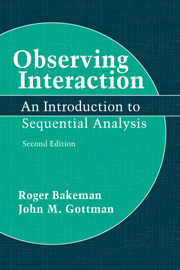Book contents
- Frontmatter
- Contents
- Preface to the second edition
- Preface to the first edition
- 1 Introduction
- 2 Developing a coding scheme
- 3 Recording behavioral sequences
- 4 Assessing observer agreement
- 5 Representing observational data
- 6 Analyzing sequential data: First steps
- 7 Analyzing event sequences
- 8 Issues in sequential analysis
- 9 Analyzing time sequences
- 10 Analyzing cross-classified events
- 11 Epilogue
- Appendix: A Pascal program to compute kappa and weighted kappa
- References
- Index
3 - Recording behavioral sequences
Published online by Cambridge University Press: 13 October 2009
- Frontmatter
- Contents
- Preface to the second edition
- Preface to the first edition
- 1 Introduction
- 2 Developing a coding scheme
- 3 Recording behavioral sequences
- 4 Assessing observer agreement
- 5 Representing observational data
- 6 Analyzing sequential data: First steps
- 7 Analyzing event sequences
- 8 Issues in sequential analysis
- 9 Analyzing time sequences
- 10 Analyzing cross-classified events
- 11 Epilogue
- Appendix: A Pascal program to compute kappa and weighted kappa
- References
- Index
Summary
Recording units: Events versus intervals
The title of this chapter, Recording behavioral sequences, suggests two different but somewhat related topics. The chapter could deal primarily with mechanical matters and describe devices used to record data, or it could deal just with conceptual matters and describe different strategies for collecting data about behavior sequences. Actually, this chapter will be a mixture of both, although conceptual and strategic matters will be stressed.
One important issue has already been raised by the example of the Bakeman and Brownlee (1980) study of parallel play in chapter 1, and that is the issue of “units.” Before selecting a particular recording strategy, an investigator needs first to decide what “units” are to be used for recording.
As we use the term, the recording unit indentifies what prompts the observer to record, and usually is either an interval or an event. For example, an investigator might choose to code time intervals, as Bakeman and Brownlee did, assigning codes to successive time intervals. This is a common strategy, but for many purposes more accurate data result when the events themselves are coded instead. In such cases, observers wait for an event of interest to occur. When one occurs, they code it (i.e., note what kind of event it was) and perhaps record onset and offset times for the event as well.
Which is better, to code events or to code intervals? That depends on a number of factors, including the kind and complexity of the coding scheme, the desired accuracy for the data, and the kind of recording equipment available.
Information
- Type
- Chapter
- Information
- Observing InteractionAn Introduction to Sequential Analysis, pp. 38 - 55Publisher: Cambridge University PressPrint publication year: 1997
Accessibility standard: Unknown
Why this information is here
This section outlines the accessibility features of this content - including support for screen readers, full keyboard navigation and high-contrast display options. This may not be relevant for you.Accessibility Information
- 2
- Cited by
